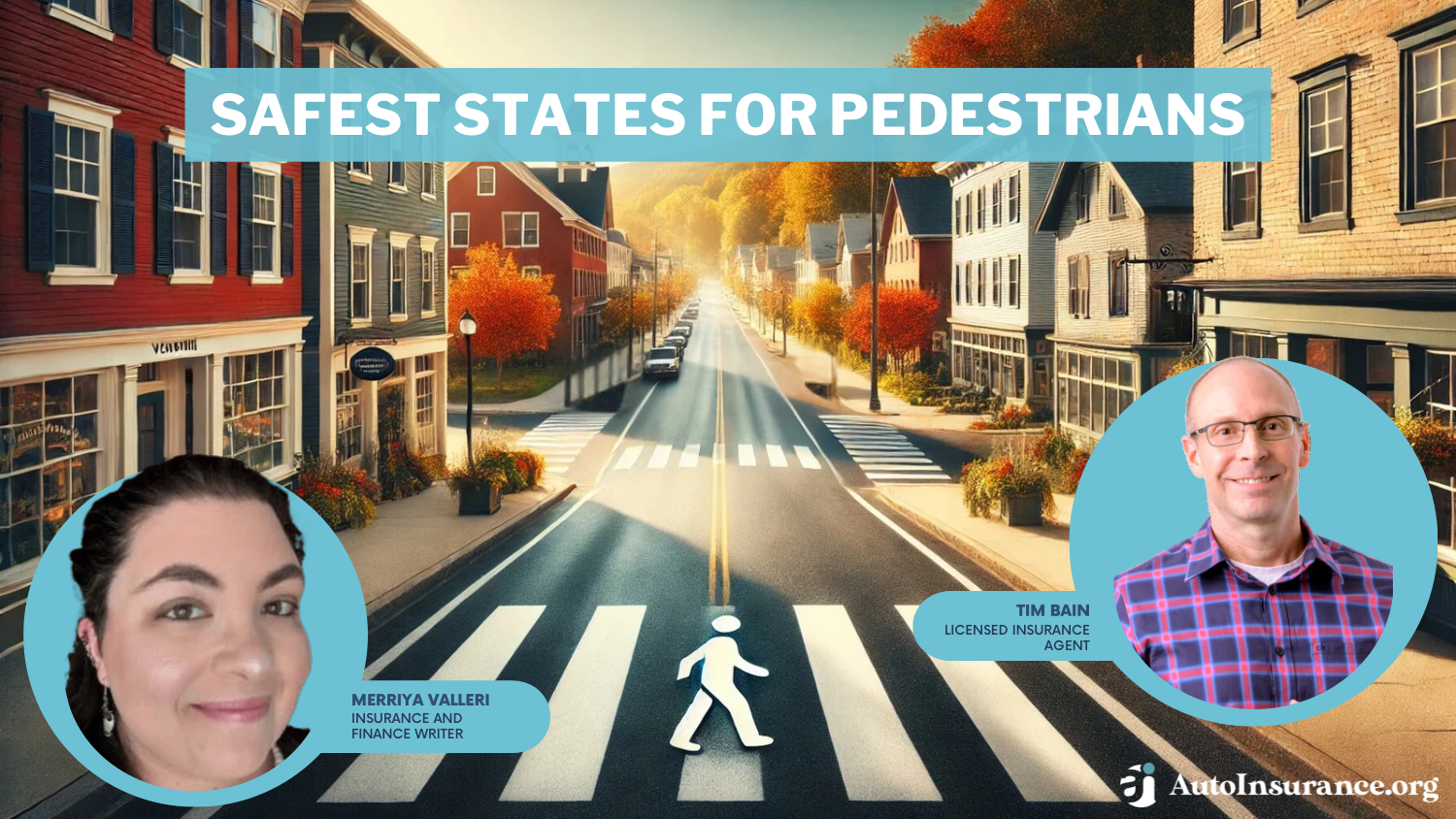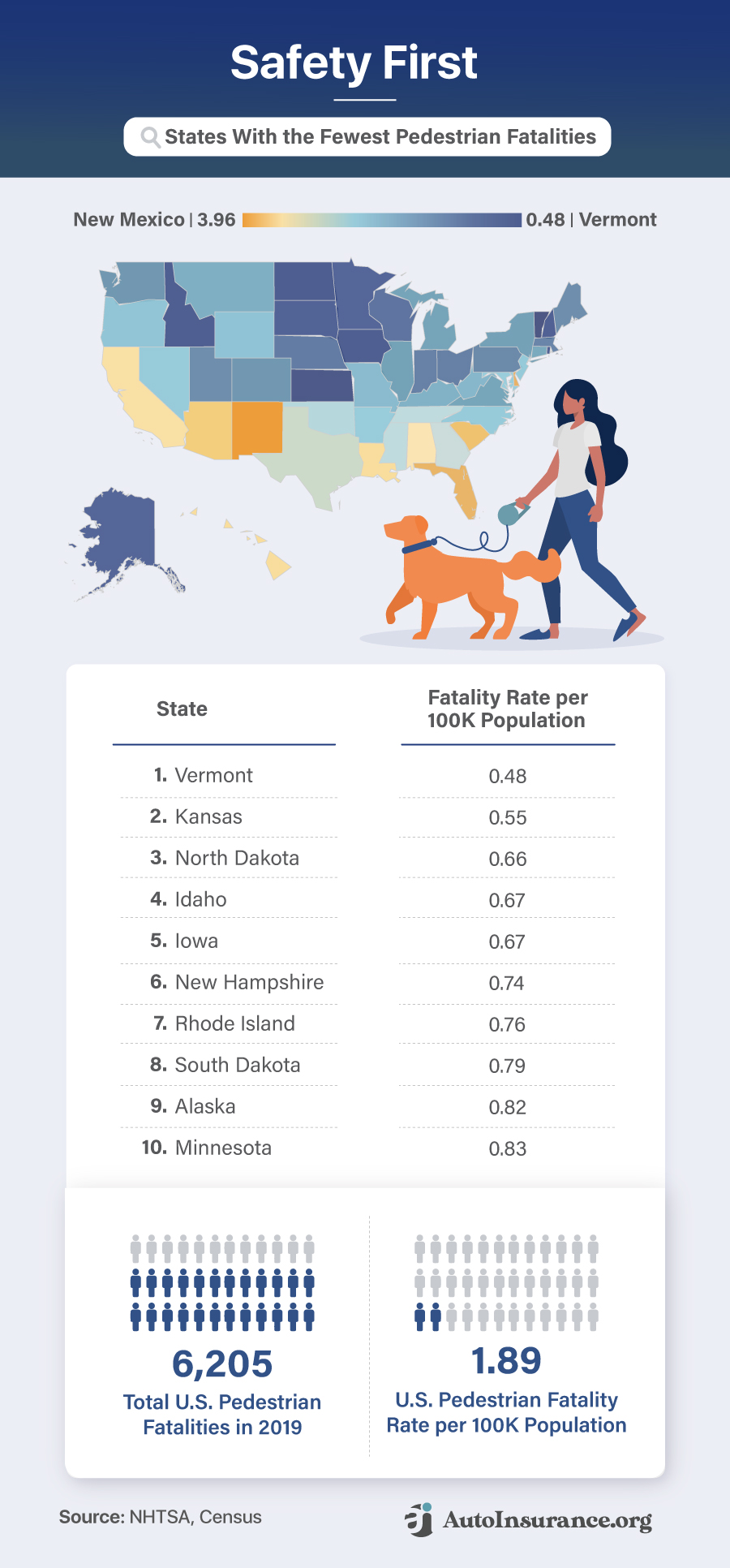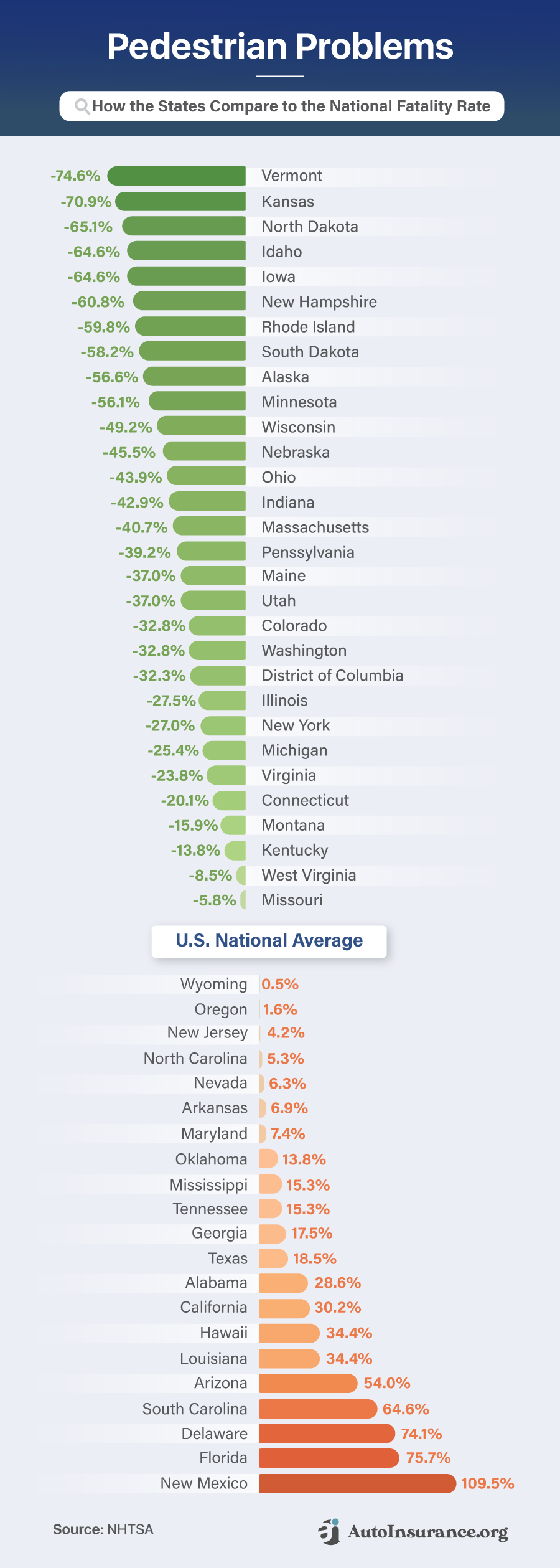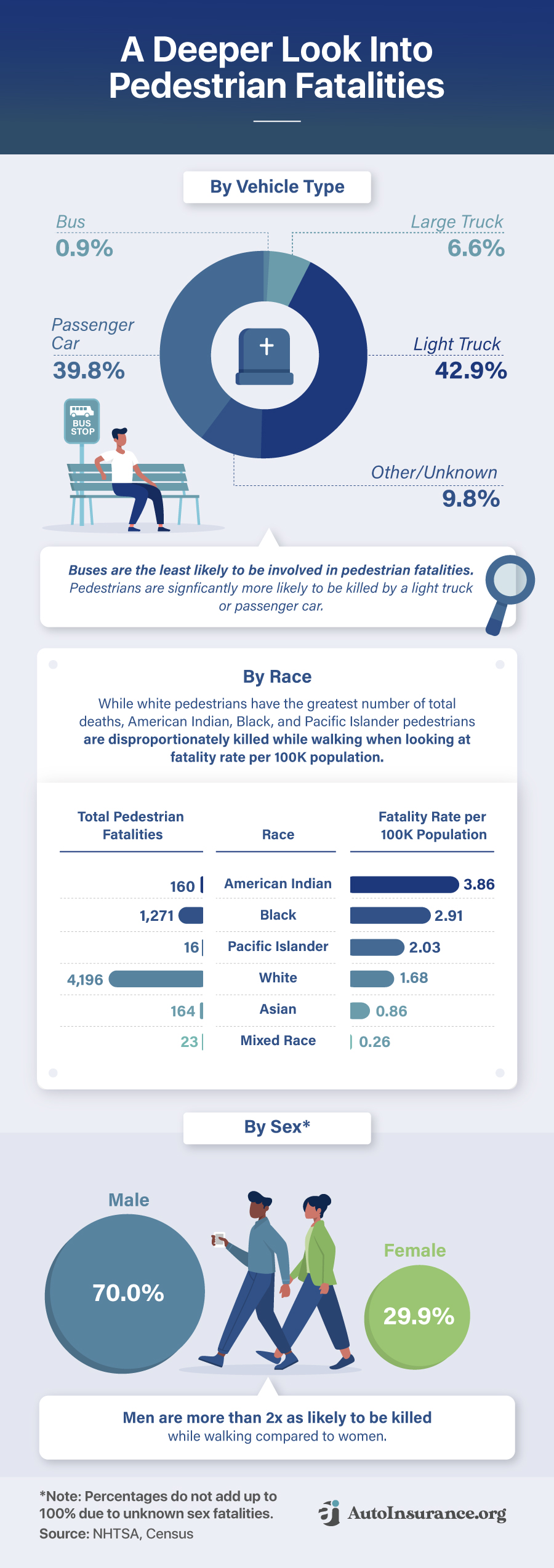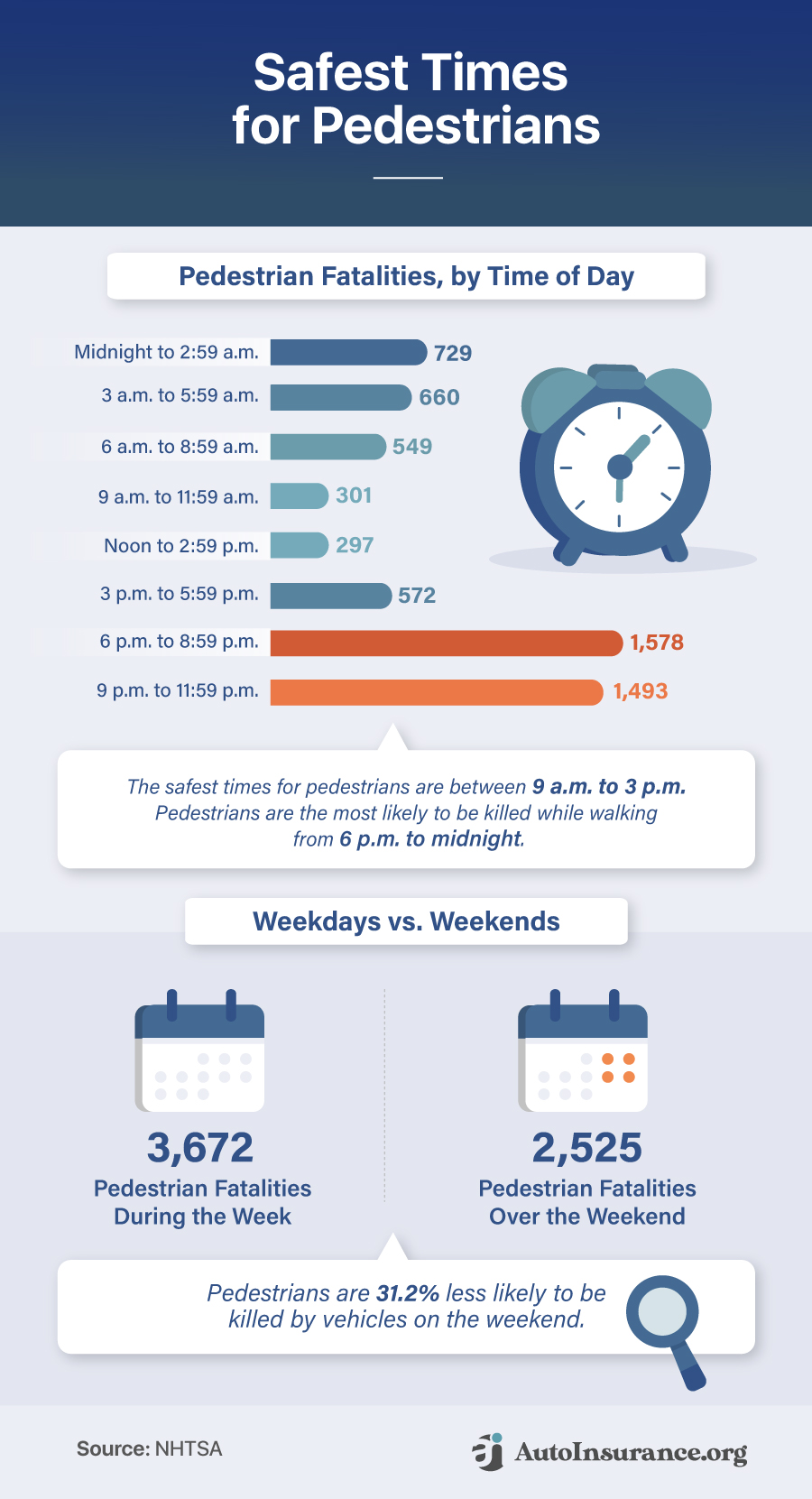Safest States for Pedestrians (2025)
Pedestrian crashes accounted for 17% of all traffic fatalities in the U.S. However, in the ten safest states for pedestrians, the total number of pedestrian deaths was 135 in 2019.
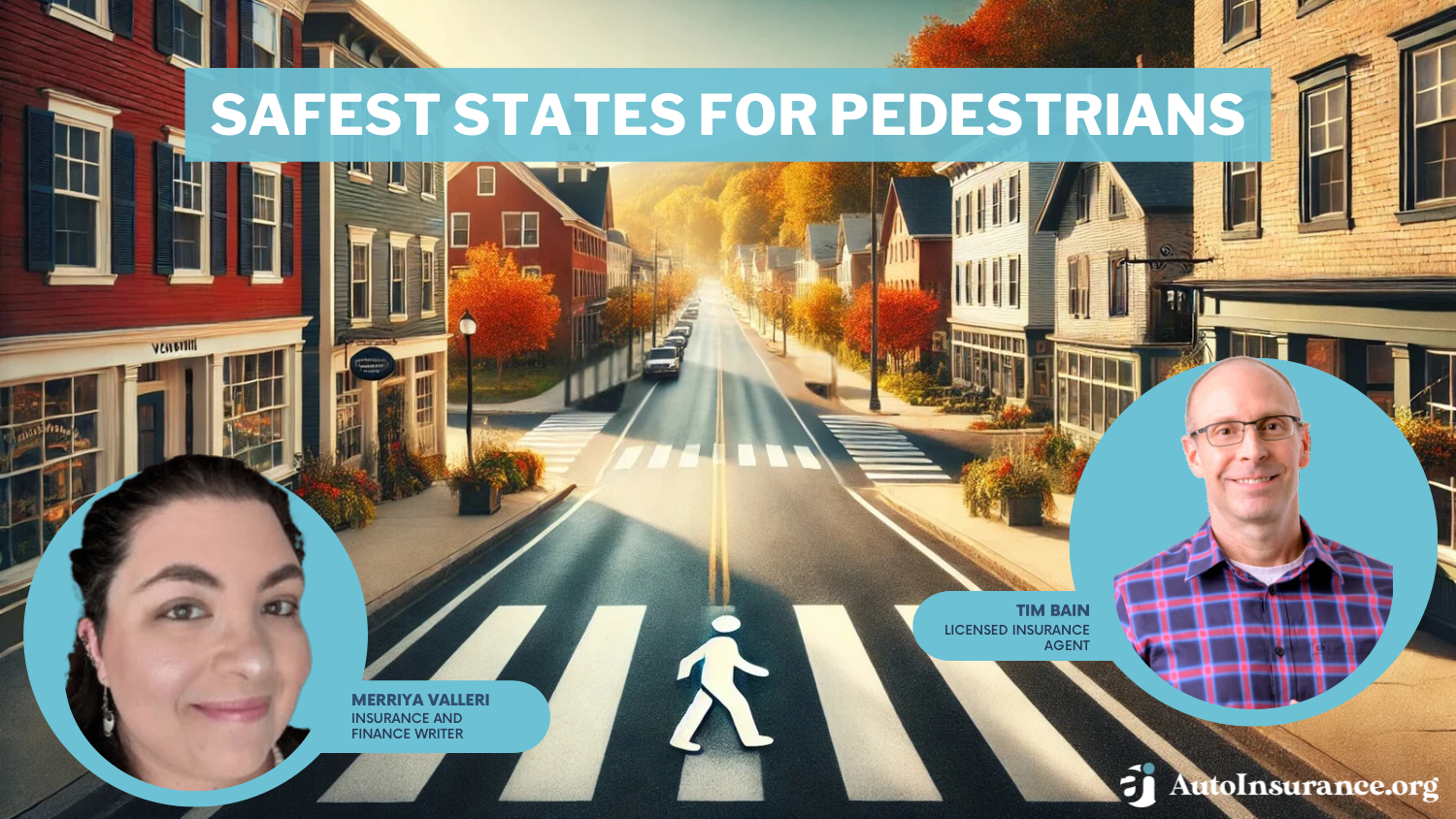
Free Car Insurance Comparison
Compare Quotes From Top Companies and Save
Secured with SHA-256 Encryption
Tim Bain
Licensed Insurance Agent
Tim Bain is a licensed insurance agent with 23 years of experience helping people protect their families and businesses with the best insurance coverage to meet their needs. His insurance expertise has been featured in several publications, including Investopedia and eFinancial. He also does digital marking and analysis for KPS/3, a communications and marking firm located in Nevada.
Licensed Insurance Agent
UPDATED: Oct 21, 2024
It’s all about you. We want to help you make the right coverage choices.
Advertiser Disclosure: We strive to help you make confident auto insurance decisions. Comparison shopping should be easy. We are not affiliated with any one auto insurance provider and cannot guarantee quotes from any single provider. Our partnerships don’t influence our content. Our opinions are our own. To compare quotes from many different companies please enter your ZIP code on this page to use the free quote tool. The more quotes you compare, the more chances to save.
Editorial Guidelines: We are a free online resource for anyone interested in learning more about auto insurance. Our goal is to be an objective, third-party resource for everything auto insurance related. We update our site regularly, and all content is reviewed by auto insurance experts.
UPDATED: Oct 21, 2024
It’s all about you. We want to help you make the right coverage choices.
Advertiser Disclosure: We strive to help you make confident auto insurance decisions. Comparison shopping should be easy. We are not affiliated with any one auto insurance provider and cannot guarantee quotes from any single provider. Our partnerships don’t influence our content. Our opinions are our own. To compare quotes from many different companies please enter your ZIP code on this page to use the free quote tool. The more quotes you compare, the more chances to save.
On This Page
Pedestrian crashes have escalated and become deadlier, with 6,205 pedestrians killed in fatal traffic accidents in 2019. This accounted for 17% of all traffic fatalities in the United States. According to the National Highway Traffic Safety Administration, the growing surge is prevalent in intersections on busy main roads in suburban or urban areas.
Pedestrian traffic fatalities by state are notably higher in low-income communities due to insufficient pedestrian infrastructure. Additionally, older pedestrians face increased risks from health issues and reduced mobility, making pedestrian impact regulations and the use of the safest cars for pedestrians crucial for their safety.
Given this context, major cities can adopt various innovative safety measures to enhance pedestrian safety. Strategies might include installing speed cameras, redesigning hazardous intersections, improving street and sidewalk lighting, and expanding dedicated pedestrian and bicycle paths. These initiatives can contribute to reducing pedestrian accidents and fatalities, a concern highlighted by statistics on US pedestrian deaths by year. Additionally, understanding factors like the safest drivers by state and the role of semi-truck stopping distances can help refine these safety strategies.
- Vermont is the safest state for pedestrians, with a death rate of 0.48 per 100,000 residents
- Pedestrians accounted for 17% of all traffic fatalities in the United States and 3% of all people injured in traffic accidents
- New Mexico’s fatality rate is 100% higher than the national average
In our ranking of the safest states for pedestrians, the Midwest and Northeast rank safer than the more populous and congested states in the South and West. To help you better understand which states rank at the top in terms of pedestrian safety, have a look at the graphic below.
Safety while driving is paramount to prevent the average car insurance cost from rising and reduce deaths on the road. We’ll also look at the safest times for pedestrians as well as pedestrian fatalities by race, vehicle type, and sex.
Ready? Let’s take a look.
States With the Fewest Pedestrian Fatalities
In this article, we’ve ranked the ten safest states for pedestrians. Our researchers analyzed car accident statistics and pedestrian fatalities from the Fatality Analysis Reporting System (FARS) and population data to determine the safest states for pedestrians.
It’s important to highlight that we frequently compare state-specific data with national statistics. The graphic below illustrates how each state aligns with the national fatality rate, including aspects such as pedestrian deaths by vehicle type and pedestrian deaths by city. Additionally, we consider how stroads and state safety measures impact these figures.
The pedestrian fatality rate in Vermont is 75% less than the national average. Conversely, New Mexico’s fatality rate is 100% higher than the national average.
Keep reading to see which states made our list.
#10 – Minnesota
Pedestrian deaths rate: 0.83
Pedestrian deaths: 47
Minnesota ranks tenth on our list of safest states for pedestrians. The pedestrian death rate was 0.83 per 100,000 residents, and 47 pedestrians died in traffic fatalities in 2019.
Minnesota has implemented various strategies to enhance pedestrian safety, such as the statewide Safe Routes to School program and a comprehensive Pedestrian Master Plan. These initiatives are designed to address issues like improving sidewalks, crosswalks, and pedestrian signals, ultimately aiming to reduce pedestrian deaths per year in the USA. By focusing on these areas, Minnesota seeks to mitigate factors that contribute to pedestrian fatalities, which can be influenced by vehicle speed and other critical factors impacting the pedestrian fatality rate.
The state also has a strong education and awareness campaign aimed at drivers and pedestrians. Minnesota’s “Share the Road” campaign is designed to remind both groups that they have a responsibility to look out for each other.
#9 – Alaska
Pedestrian deaths rate: 0.82
Pedestrian deaths: 6
Alaska is ninth on our list of safest states for pedestrians. In Alaska, the pedestrian death rate was 0.82 per 100,000 residents, and six pedestrians died in traffic fatalities. Alaska has a number of measures in place to improve pedestrian safety, including a statewide Safe Routes to School (SRTS) program and a Bicycle and Pedestrian Plan that focuses on improving sidewalks, crosswalks, and pedestrian signals.
The state also boasts a robust education and awareness initiative directed at both drivers and pedestrians. The Alaska Statewide Highway Safety Media Campaign effectively informs road users about safety projects, including designated safety corridors. This campaign highlights both beneficial and risky behaviors, contributing to making the state one of the safest states to live in. With a focus on prioritizing pedestrians first, this campaign supports the state’s reputation as one of the most safe states.
#8 – South Dakota
Pedestrian deaths rate: 0.79
Pedestrian deaths: 7
South Dakota comes in at number eight on our list of safest states for pedestrians. In South Dakota, the pedestrian death rate was 0.80 per 100,000 residents. There were seven pedestrian deaths in traffic fatalities in 2019.
The safety measures for pedestrians on South Dakota’s roads are primarily informed by the Highway Safety Plan, developed with input from a wide range of stakeholders, including law enforcement, public health experts, and representatives from the transportation and engineering industries.
The plan focuses on improving safety for all road users but focuses on pedestrians and cyclists. Key goals include increasing the use of sidewalks and crosswalks and enhancing the visibility of pedestrians and cyclists at night.
#7 – Rhode Island
Pedestrian deaths rate: 0.76
Pedestrian deaths: 8
The seventh position in this ranking is Rhode Island, with a pedestrian death rate of 0.76 per 100,000 residents and eight pedestrians dead in traffic fatalities. Rhode Island has formulated plans for pedestrian and bicycle safety that cover a wide range of topics to improve pedestrian safety.
The state also makes a concerted effort to improve lighting on streets and sidewalks, which can improve visibility for drivers. In addition, the state also has a vital education and awareness campaign for drivers and pedestrians.
Share the Rhode is a campaign that educates both groups about the importance of looking out for each other while driving and walking.
#6 – New Hampshire
Pedestrian deaths rate: 0.74
Pedestrian deaths: 10
New Hampshire ranks sixth safest for pedestrians, with a pedestrian death rate of 0.74 per 100,000 residents and 10 pedestrian fatalities.
Bike-Walk Alliance of New Hampshire has several resources available to improve pedestrian safety, including an online map of safe routes to school and a toolkit for communities that want to start a Safe Routes to School program. The state also has a strong law enforcement presence, which helps to enforce traffic laws that protect pedestrians.
#5 – Iowa
Pedestrian deaths rate: 0.67
Pedestrian deaths: 21
Iowa comes in at number five on our list of safest states for pedestrians with a pedestrian death rate of 0.67 per 100,000 residents and 21 pedestrians who died in traffic fatalities.
Iowa has a Bicycle and Pedestrian Long-Range Plan that sets out a vision for improving pedestrian and cyclist safety, focusing on creating complete streets that are safe for everyone. The plan also includes several policy recommendations and funding priorities. One key focus is improving intersection safety, which can be a significant hazard for pedestrians.
#4 – Idaho
Pedestrian deaths rate: 0.67
Pedestrian deaths: 12
Idaho makes fourth place on our list of safest states for pedestrians. It has a pedestrian death rate of 0.67 per 100,000 residents and 12 pedestrian fatalities.
The Idaho Transportation Department of Highway Safety has put together a plan to improve pedestrian safety. The Idaho Pedestrian and Bicycle Safety Program focuses on increasing sidewalks and crosswalks, improving lighting, and enhancing driver awareness of pedestrians.
Additionally, the Children Pedestrian Safety Program aims to educate drivers and children about the dangers of walking near roads.
#3 – North Dakota
Pedestrian deaths rate: 0.66
Pedestrian deaths: 5
North Dakota comes in at number three with a pedestrian death rate of 0.66 per 100,000 residents, and five pedestrians died in traffic fatalities in 2019.
The North Dakota Department of Transportation’s Vision Zero highway safety plan aims at reducing traffic deaths. This plan includes strategies to enhance pedestrian safety, including curb extensions, countdown timers, median refuge islands, and more.
The Safe Routes to School program also aims to make it safer for kids to walk and bike to school.
#2 – Kansas
Pedestrian deaths rate: 0.55
Pedestrian deaths: 16
Kansas ranks as the runner-up safest state for pedestrians, with a pedestrian death rate of 0.55 per 100,000 residents, and 16 pedestrians died in traffic fatalities in 2019.
The Kansas Department of Transportation has the Bicycle and Pedestrian Program that works on goals for safety, mobility, education, and more.
Kansas law enforcement agencies have also conducted campaigns to raise safe-driving awareness and consider the safety of others on the road. For example, the officers carried out the SAFE (Seatbelts Are For Everyone) Program for high school students in 2021. Other law enforcement agencies in Oklahoma and Missouri also participated in the campaign.
The campaign’s goal was to remind teens of the importance of driving safely while enforcing traffic laws that protect pedestrians.
#1 – Vermont
Pedestrian deaths rate: 0.48
Pedestrian deaths: 3
Vermont takes the number one spot as the safest state for pedestrians. It had three pedestrian deaths with a death rate of 0.48 per 100,000 residents.
The Vermont Agency of Transportation created the Pedestrian Safety and Vulnerable Road User Toolkit in partnership with the Vermont Department of Health to help towns and municipalities improve pedestrian safety.
The Toolkit includes several resources, such as best practices, case studies, and funding opportunities. It’s been recently updated to reflect the latest guidance from the National Highway Traffic Safety Administration on pedestrian safety.
Free Auto Insurance Comparison
Enter your ZIP code below to view companies that have cheap auto insurance rates.
Secured with SHA-256 Encryption
A Deeper Look Into Pedestrian Fatalities
We also took a deeper look into pedestrian fatalities based on vehicle type, race, and sex. You can see these insights in the table below.
Analyzing the data reveals that cars and trucks are the most frequent causes of pedestrian fatalities, while buses are the least likely to be involved in such incidents. Among different racial groups, American Indian, Black, and Pacific Islander pedestrians are more at risk of being killed in traffic accidents compared to white pedestrians.
Additionally, males are more than twice as likely to suffer fatal pedestrian accidents as females. These trends underscore the common causes of pedestrian accidents and highlight the dangers in the deadliest cities for pedestrians. Distracted pedestrian statistics further emphasize the critical need for increased awareness and safety measures.
Best Times for Pedestrians
The safest time for pedestrians to walk is 9 a.m. to 3 p.m. However, even then, pedestrians are still at risk. Pedestrians are most likely to be killed while walking between 6 p.m. and midnight.
On weekdays, there are 3,672 fatalities, while on the weekends, there were 2,525 fatalities. This is a difference of 1,147 pedestrians. Learn more in the graphic below.
Thought Leaders Weigh in on Pedestrian Safety
We consulted with leading experts in pedestrian safety to gather valuable insights on improving pedestrian protection for this segment. Our interviewees included lawyers, business owners, and road-safety advocates. They provided important perspectives on pedestrian fatality rates by city, the chances of getting hit by a car while walking, and strategies to mitigate fatal pedestrian accidents. Let’s explore their recommendations.
“Florida has the second-highest rate of pedestrian deaths among the states. In Florida, these rates are likely associated with high tourism, DUIs, and a large senior population. In regard to tourism, the Tampa Bay Times released a statement saying tourism has reached a new peak here in Florida. And specifically, Florida’s tourism grows dramatically in the winter and spring seasons.
For many snowbirds and spring breakers, Florida is a place to unwind and drink, but this only increases their chances of getting into an accident, even if they are walking. Florida pedestrians are notorious for crossing the street whenever it’s convenient, far from the crosswalk.
Having been born and raised in Florida and having seen case after case of pedestrian accidents, a pattern emerges, and the data backs it up. When mixed with tourists, the elderly, or drunk drivers, a pedestrian can be too slow to react to cars, leading to the second-place on the pedestrian deaths ranking for the highest rate of deaths.
Per the CDC, nearly half of all car accidents that resulted in a pedestrian death involved a driver or pedestrian influenced by alcohol.
In other words, almost half of the pedestrian deaths could’ve been prevented if pedestrians and drivers drank responsibly and acted accordingly.
Also, the GHSA points out around 75% of pedestrian deaths occur in the dark, which lines up with common drinking times and poorer sight lines for drivers.
With those statistics in mind, how can pedestrians avoid accidents? Interestingly enough, pedestrians may have more control than drivers. Pedestrian motor vehicle accidents typically involve a vehicle that is already moving at high speeds. Most pedestrian accidents can be avoided with self-awareness and patience. More simply, a pedestrian can avoid accidents by following these simple steps:
- Wear bright or light clothing that can be seen at all times of the day.
- Avoid drinking if you have to walk more than a block to your sleeping accommodations.
- Always walk on the crosswalks and sidewalks, and only use crosswalks when crossing lights give the go-ahead.
- Stay alert and keep off phones and gadgets.
- Look both ways before crossing the street.
- At crosswalks, wait until vehicles stop before crossing as not everyone sees the stop signs and lights.
- Ride an Uber, Lyft, or other ride-sharing services if necessary.
Indeed, some cases are unavoidable. However, if pedestrians and drivers followed these steps, countless lives would be saved.”
Clayton Moore is a legal intern for TrippFirm.com.
Tripp Firm has represented victims of pedestrian accidents since 2007.
Why are some states safer for pedestrians than other states?
“Some states are safer than others for pedestrians. One of the primary reasons for these discrepancies is the driving infrastructure. America’s urban and suburban layout has been designed primarily for vehicles, and pedestrians have only ever been an afterthought.
Six-lane highways have hastily added crosswalks, but the right of way remains with motorists. Limited signage makes it difficult for drivers to stop in time for pedestrians.
We consistently see road layouts that prioritize pedestrians in states with lower pedestrian deaths. Speed bumps and traffic-calming measures keep drivers at a safe speed. Crosswalks are fitted with traffic lights, and early signage makes it clear to drivers that pedestrians have the right of way.
The legal framework under which drivers operate also has a huge impact on pedestrian safety. In many places, speed limits are policed barely, if at all. Although drivers hate them, speed cameras have a huge impact on pedestrian safety.
Laws around distracted driving are also hugely important. In the United States, 48 out of 50 states have made texting and driving illegal, but penalties vary dramatically. States with stricter penalties, especially for repeat offenders, are safer for pedestrians.
Lastly, studies have shown that Black and Native American populations, older populations, and individuals from low-income areas are disproportionately likely to be pedestrian victims of car accidents.
Largely, this has to do with the neighborhoods they’re from — urbanized communities with poor investment in road infrastructure. There’s an intersection between the socioeconomic causes and the infrastructural reasons for pedestrian safety.”
What actions can state and local governments take to increase safety for pedestrians?
“Although we might think it’s the responsibility of drivers to make pedestrians safer, there’s a lot that local and state governments can do to improve the safety of our streets for pedestrians.
One solution to address the issue of the highest pedestrian deaths per city is to modify road layouts to prioritize pedestrian movement. At high-traffic intersections, it is essential to install traffic lights at crosswalks. Similarly, on streets with higher speed limits, traffic lights are crucial because relying on drivers’ stopping times alone is not always effective for ensuring pedestrian safety. Traffic lights provide drivers with sufficient time to slow down, thereby reducing the increase in pedestrian deaths and helping pedestrians cross safely.
It’s not all about traffic lights either. Traffic-calming measures are common in Europe but rare in the U.S. They are highly effective at reducing average speeds, especially in urban areas. These measures can include speed bumps and traffic islands which slow drivers down and encourage attentive driving.
Local governments have the power to introduce these traffic-calming measures, so there are no legislative barriers to putting these in place.
As mentioned, laws around distracted driving have a huge impact on pedestrian safety. New Hampshire has one of the toughest distracted driving laws in the country. When behind the wheel, texting, making calls, and even programming GPS devices are banned in New Hampshire. These laws apply both while the vehicle is moving and while it’s stationary at intersections.
How has technology contributed to the rise in pedestrian safety?
“Although any increase in pedestrian safety is contested, there’s the strong hope that technological advancements are going to make our roads safer for pedestrians. Technological changes are taking place both in vehicles and in our road infrastructure to increase pedestrian safety.
Self-driving technology in our vehicles is improving pedestrian safety standards.
Level 2 automation in cars includes a range of features that detect hazards via sensors, well in advance of when a driver could react. These sensors can signal to the vehicle when a cyclist or pedestrian is on the road, and automatic braking can take over when there’s the risk of a collision.
Many people don’t realize that computers already determine our road layouts to a significant degree. Traffic management systems are optimized to facilitate the flow of traffic. Thanks to improved AI and thermal cameras at intersections, these systems can better take pedestrians into account and update road layouts to prioritize pedestrian safety.
It’s not all about AI, though. There are simple technological solutions to pedestrian safety, too. For example, adding a timer to traffic lights gives both drivers and pedestrians an instant cue to who has priority on the road and for how long.
These timers reduce driver frustration, improve pedestrian knowledge, and have been shown to reduce pedestrian deaths. The best thing about these solutions is that they’re inexpensive to implement and immediately intuitive to all road users.”
What can drivers do to keep pedestrians safe?
“Of course, it’s always worth talking about what drivers can do to keep pedestrians safe. Even while acknowledging that the primary approach to pedestrian safety should come at a government level, driver behavior is the first and last thing we can look at to improve pedestrian safety.
Here are a few of the most important things:
- Stop distracted driving. This is a huge one. The prevalence of digital devices, including dashboard screens and GPS systems, has made distracted driving a new scourge. Drivers often engage with these systems at low speeds in urban areas when they assume it’s ‘safe’ to do so. I’d urge all drivers to be aware of the distractions in their vehicles and to resist them at all times.
- Don’t overtake vehicles at crosswalks. If a car is stopped at a crosswalk, it’s likely there’s a reason for it. Don’t let impatience take over, causing you to pass the stopped vehicle. This is especially important as the vehicle in front will hinder your view of the road, so you could easily miss a pedestrian as you’re overtaking.
- Stop for red lights. Stopping for red lights and slowing for yellow lights will hugely reduce the risk of a collision with a pedestrian. Many drivers see amber as a cue to speed up, but a more cautious and safe approach is to practice patience and slow down for the amber light in advance of the red.
- Keep your speed down. While drivers shouldn’t be breaching the speed limit, I’d actually encourage drivers to slow down even further, especially in urban areas. Even at 30mph, a driver’s stopping distance could be as much as 90 feet; this is more than halved if the driver reduces their speed to 20mph, which could make all the difference for pedestrians.
Unfortunately, changed habits during the pandemic saw pedestrian deaths spiking in 2020 and 2021. Let’s hope that some of the actions outlined above can reverse the trend.”
Robert Muñoz is a road safety expert with SensibleMotive.com.
He provides info about driving, road safety, and auto accessories.
Why are some states safer for pedestrians than other states?
“Some states tend to be safer for pedestrians than others due to a few factors. First, accidents tend to vary based on the number of drivers on the road. The more drivers there are on the roads, the more likely it is for an accident to occur.
Another factor is how many young or inexperienced drivers are on the road. Those who are new to driving are more at risk of an accident due to underestimating or not being able to recognize roadway risks.
Issues like distracted driving, not wearing a seatbelt, speeding, and getting behind the wheel under the influence of alcohol or drugs also play a factor in why this group of drivers tends to have more frequent dangerous accidents. In fact, motor vehicle accidents are the second leading cause of death for teens.
Finally, states often vary in terms of speeding laws on roadways. Since the National Maximum Speed Law was repealed in the 1990s, states, regions, and cities have set their own speed limits and, unfortunately, since then, traffic fatalities overall have risen.”
What makes the roads for pedestrians in your area safe or dangerous?
“New York City, like many other areas with a high population of pedestrians, cyclists, and motorists on the roadways, is at high risk for accidents. According to the NYC Department of Transportation, from 2020 to 2021, the number of pedestrian deaths in New York City rose from 26 to 41 — a 58% increase.
Although 2020 was an unprecedented year due to the COVID-19 pandemic, the rate of pedestrian deaths was still higher in 2021 compared to 2019 (34 deaths) and 2018 (31 deaths).
Due to the prevalence of deadly accidents on city streets, since 2014, NYC has adopted ‘Vision Zero,’ a city-wide initiative to prevent fatal accidents through engineering, enforcement, and education.
Under Vision Zero, the city has expanded enforcement against dangerous moving violations, added new street designs and configurations to improve safety, implemented broad public outreach and communications, and added a sweeping legislative agenda to increase penalties for dangerous drivers and give New York City control over the safety of the city’s streets.”
What actions can state and local governments take to increase safety for pedestrians?
“State and local governments can improve safety for pedestrians by lowering speed limits in high pedestrian traffic areas, updating signs to include reflective, durable lens sheeting, and implementing flashing LED signs, especially at frequently used crosswalks and in school zones.
States should consider implementing a zero-tolerance law for drivers under the age of 21 who drink and drive. On holidays that are notorious for higher rates of drinking and driving accidents such as New Year’s Eve, Thanksgiving weekend, and the 4th of July, it may be necessary to implement both sobriety checkpoints and high-visibility saturation points.”
How has technology contributed to the rise in pedestrian safety?
“An obvious piece of technology impacting pedestrian safety is, of course, cell phones. But one that not everyone discusses is Bluetooth capabilities linking to multiple devices. These days, people are virtually ‘plugged in’ to everything — from their phones to wireless headphones, smartwatches, GPS devices, and more, even while on the go.
With notifications constantly popping up on screens on phones, watches, and the audio console, it can be incredibly distracting for the driver.
Headphones also seem to be another growing issue. Wearing headphones while driving can be extremely dangerous, not only for the driver but also for their passengers, pedestrians, and other vehicles on the road.
Even though it may seem like a ‘hands-free,’ safe alternative to talking on the phone, it creates a major distraction and causes a significant decrease in situational awareness, which can increase the likelihood of an accident.”
What can drivers do to keep pedestrians safe?
“Drive with your eyes on the road and avoid distractions behind the wheel. Make sure that all your devices are either muted or on airplane mode while driving. Also, avoid common distractions like eating or drinking behind the wheel, putting on makeup, listening to music too loud that you can’t hear other cars, watching or recording videos, and, of course, texting or taking a phone call.
When in high pedestrian traffic areas, reduce your speed and be on the alert for pedestrians and cyclists on the road. Try to review the directions of your trip prior to hitting the roadways so you aren’t constantly looking back and forth at the GPS.”
What can pedestrians do to minimize the chances of getting in a traffic accident?
“Same as drivers, pedestrians should take caution when on the roads to keep everyone safe. They should avoid wearing headphones, especially noise-canceling ones, that limit them from hearing traffic sounds. They should also look both ways, even when using a crosswalk.
Try to wear bright or reflective clothing, especially at dusk and nighttime. Always hold the hands of children when crossing the road and if a ball or pet goes out into the street, avoid running after them until you know it is safe to do so.”
Adam Hurwitz is a personal injury lawyer with The Perecman Firm.
He is an experienced trial lawyer with a background in traffic accidents.
Why are some states safer for pedestrians than other states?
“Pedestrian deaths continue to increase overall in the U.S. Pedestrian safety and deaths depend on a lot of factors such as the number of vehicles in a region, population density, fuel price, social factors (e.g., driving habits), and demographic characteristics (e.g., age, race, education, income, and the gender distribution of the population).”
What makes the roads for pedestrians in your area safe or dangerous?
“I am in New Mexico, and we do not have a high number of deaths, but unfortunately, we have one of the highest rates of pedestrian deaths across the nation. If more people lived in New Mexico, there would be more deaths. So our death rates per 100,000 people are the highest, but we do not contribute to most deaths in the nation due to our small population.
This rate could be related to education and income (we rank among the lowest) and the driving habits of people. Overall, New Mexico and my area would not be considered the safest in the nation or region.”
What actions can state and local governments take to increase safety for pedestrians?
“A variety of actions can increase pedestrian safety such as awareness campaigns, policies, and engaging communities and law enforcement in discussion and strategies for reduction of pedestrian deaths.
The following measures will help increase pedestrian safety:
- Having controlled crossings
- Improving street design and connectivity
- Having dedicated spaces and rules to protect pedestrians
- Using traffic-calming measures (e.g., speed breakers, tables, bumps, chokers, etc.) for residential areas
- Reducing traffic speeds at key avenue
- Having functional devices (e.g., traffic lights)”
How has technology contributed to the rise in pedestrian safety?
“Technology has helped in multiple ways. For example, technology and surveillance have ensured safer driving. Another key example would be traffic lights, especially those with buttons for pedestrians to register and warn of their impending movement and crossing. More evidence is emerging on vehicles with the technology to foresee and sense pedestrians from a distance to apply brakes.
In the near future, we will see a continued rise in the use of technology and more innovation from the road infrastructure standpoint and the vehicle side as well.”
What can drivers do to keep pedestrians safe?
“Many actions by drivers can ensure pedestrian safety. Drivers have to anticipate that they could be in an area of high risk or that pedestrians may not always be watchful. For example, I have always lived on college campuses, and students often cross roads without paying attention or are using headphones or other distracting devices.
Drivers must follow the rules and guidelines, avoid distractions (such as cellphone usage), be mindful when driving, avoid drinking and driving, stay vigilant about traffic and human movement around them while driving, and anticipate sudden speed and direction changes.”
What can pedestrians do to minimize the chances of getting in a traffic accident?
“A lot of the onus is also on pedestrians. They should avoid crossing streets without looking around, follow traffic signals, and not cross roads while talking on the phone.
Pedestrians should avoid using headphones on the street as they may miss hearing warning horns and sounds and should be alert, especially when carrying heavy stuff or hauling. Just like drivers, pedestrians should anticipate problems and risks, such as drivers speeding or not obeying traffic signals.”
If you have a story about a driver-pedestrian close call, please share.
“This has occurred to me both as a driver and a pedestrian. Having lived on school or college campuses almost half of my adult life, at a younger age, I was not very careful as a pedestrian and was fortunate not to be hit by moving vehicles while distracted by my phone.
When I graduated and started working for universities, I tried to be very careful and maintain a very low speed around campuses. Still, you always have some student pedestrians who appear from nowhere, and I have learned to anticipate and respond to such problems.”

He has many publications on public safety and disability burdens.
Why are some states safer for pedestrians than other states?
“States that have more strict laws, better enforcement, and more sidewalks are safer than states where they don’t. Also, states in warm climates are safer than cold climates because people walk year-round when in warmer weather.
Many states with higher population density, such as California, Texas, and Florida, were the top states for pedestrian deaths. Other states with higher rural populations, such as North Dakota, South Dakota, and Vermont, saw relatively lower numbers.
While these figures are alarming, it is important to note that cyclists and pedestrians still make up only a small percentage of all traffic fatalities. NHTSA data shows that although there have been rapid increases in smartphone usage over the past few years, distracted driving remains a leading cause of accidents.”
What makes the roads for pedestrians in your area safe or dangerous?
“The roads here in southwest Ohio where I live are pretty safe for pedestrians. We have many sidewalks, bike paths, and miles of paved shoulders on our roads. Most people here drive slower because there’s no rush-hour traffic. Additionally, most of the drivers are respectful of pedestrians because we all know each other from our friendly small-town communities.
The main problem we do have with pedestrian safety is when people walk along the roadways at night without any reflective clothing or lights on their clothes or backpacks, which is required by law.”
Why are pedestrian safety issues increasing?
“There are many reasons why pedestrian issues seem to be on the rise today. One of the largest contributing factors is distracted driving. Gone are the days when people were simply smoking cigarettes behind the wheel. Today’s drivers are texting, reading emails, and posting on social media while driving.
They may be listening to loud music or talking on the phone with a hands-free device while they drive; all of these things can lead them to lose track of what’s going on around them and run into a pedestrian who has stepped into the road without warning.”
Max Turner is the CEO of CarDonationCenters.org.
His business connects vehicle donors to charities.
What makes the roads for pedestrians in your area safe or dangerous?
“My area in Hunterdon County, NJ, a mix of suburban and rural housing, including farmland, with lots of wide-open acreages. The roads are a mix of narrow two-lane roads and four-lane divided roadways. Most rural intersections are uncontrolled or have two-way stop signs.
On the rural roads, street lighting is almost non-existent, there are few sidewalks, and many streets have overgrown foliage or wooded areas alongside, offering little extra room for pedestrians. Overall, I would rate most of the roadways in this county as dangerous for pedestrians.”
How has technology contributed to the rise in pedestrian safety?
“Technology that makes vehicles and pedestrians more conspicuous to each other has been a contributor to such safety. Improved vehicle lighting helps drivers see pedestrians and helps pedestrians see vehicles.
Electric vehicles (EVs), sales of which are on the rise, are required to emit a sound to make them more obvious, as these vehicles no longer have a relatively noisy ICE (internal combustion engine) to help alert pedestrians.
Cars have blind spots to the sides and rear. Inside and outside mirrors help but don’t always cover the entire field of view. In recent years, backup and surround-view cameras have become standard or optional on almost all new vehicles.
While primarily used for driving in tight parking spots, the cameras also help spot those on foot. The seamless integration into a dashboard screen or rear-view mirror makes them convenient to use. However, drivers should still check their surroundings manually as well.
Most new models also include forward and rearward collision warning and automatic emergency braking systems. These systems have become more sophisticated recently and can detect pedestrians of all sizes as well as bicycle riders. Even if they cannot bring a vehicle to a complete stop in time, they may scrub off enough speed at impact to reduce injuries.”
What can drivers do to keep pedestrians safe?
“First and foremost, drivers must recognize that their 4,000+ lb. (2 ton+) machine is no match for someone on foot. Any contact between the two is almost guaranteed to cause harm. That said, the driver has a significant responsibility to remain alert to pedestrians. Drivers must pay attention to the road, be aware of their surroundings, and practice defensive driving.
Active steps that any driver can implement include making their vehicle more conspicuous to others by using headlights at dawn and dusk and using signals when turning.
Avoid unnecessary distractions such as loud music, eating, and texting while driving. Maintain the speed limit, and slow down in times of poor visibility, especially at night and during precipitation. When you see a pedestrian, give them as wide a berth as practical without putting yourself in danger.
Never presume which way they will move, and mentally prepare an escape route should a pedestrian end up in your path.”
What can pedestrians do to minimize the chances of getting in a traffic accident?
“Just as we stated that drivers must be on full alert, that is true for pedestrians also. The ubiquitous cell phone can become a distraction, made all the worse if the user is wearing earbuds or a headset.
Pedestrians walking where there are no sidewalks must share the road and the responsibility for safety. Be especially mindful at uncontrolled intersections, as drivers will not stop and may be caught by surprise by a pedestrian suddenly appearing in the road in front of them.
Aside from obvious practices such as only crossing at intersections and obeying all traffic signals, pedestrians should also make themselves more conspicuous to drivers.
Walk on the side of the road facing traffic, and not with traffic behind you, so that you can quickly move out of harm’s way if necessary. Wear light-colored clothing, or better still, reflective clothing. Carry a flashlight if walking during times of reduced light.
If you are walking a pet, keep the pet on a short leash and be prepared to move off the roadway if traffic becomes heavy or if a vehicle comes too close.”
Richard Reina is a product training director for CARiD.com.
CARiD sells aftermarket auto parts.
Why are some states safer for pedestrians than other states?
“Of course, there are always the usual suspects relating to speed limit laws in particular states, but in my travels, I’ve noticed a correlation between population density and the number of accidents that pedestrians face. It’s simple; the more people are close together, the more likely someone gets hit by a car.
Another observation is that most pedestrian accidents happen after dark. States that are famous for their nightlife usually end up topping the charts for the number of pedestrian accidents. Surprisingly, the weather also plays a part. I can cross roads easily without difficulty in colder states because most people usually stay inside. The same can’t be said for warm states.”
What can drivers do to keep pedestrians safe?
“My first recommendation would probably be to tell drivers to be patient. Unfortunately, some of the pedestrian accidents that I’ve seen usually happened due to either a distracted driver or an impatient one. While it’s understandable that you might be in a rush, it won’t cost you more than a minute to stop for pedestrians at a crosswalk.”
What can pedestrians do to minimize the chances of getting in a traffic accident?
“I usually love walking around to get a better feel of the area during my travels. So, these are some of the tips that I use for my safety. First, always look left and right before crossing the road. If a vehicle is approaching, make sure that you’ve caught the driver’s attention with a hand-wave before you proceed.”
What actions can state and local governments take to increase safety for pedestrians?
“Personally, I’ve always found myself feeling safer while traveling in countries or states where there’s strict implementation of speed limits as well as numerous pedestrian facilities. In my opinion, local governments can work on good street lighting and constructing safe crossings across multiple points on the road.”
Jenny Ly is the founder of GoWanderly.com.
Her site provides travel guides and trip itineraries for over ten countries.
“The number one reason for car accidents in the U.S. is distracted driving. With our ever-present smartphones, it can be hard for drivers to focus on the road when their devices are in front of them. With distracted driving, the responsibility is on the driver to keep others safe on the road.
Maryland has launched a number of campaigns in recent years to encourage safe driving. These programs, such as Look Alive, Look Out, and Street Smart, feature safety messaging that targets drivers and pedestrians to encourage safe behaviors and inform traffic safety laws.
Ocean City, Maryland, has the Walk Smart campaign, which aims to integrate the four Es (Engineering, Education, Enforcement, and EMS) of traffic safety into pedestrian safety. Because of these measures, the number of pedestrian-involved crashes in Maryland has been steadily decreasing over the years.
One of the biggest things pedestrians can do to minimize their chances of getting in an accident is to know their rights. One of the major rights in regards to pedestrian safety that pedestrians have is the right to cross at crosswalks.
Crosswalks help pedestrians safely and lawfully cross the street. A crosswalk at an intersection or stoplight is usually a safe place to cross, but pedestrians must yield the right-of-way to oncoming traffic until receiving the sign to cross, which is most commonly a walking person or a green light.
When pedestrians receive the sign to cross, drivers must yield the right-of-way. This includes drivers trying to make left or right turns. Even when there is a green light, turning drivers must yield to pedestrians in crosswalks. If the crosswalk signal indicates pedestrians should not walk, however, they must yield to drivers.
It is your responsibility as a pedestrian to obey all traffic regulations, crosswalk signals, and traffic-control devices.
If you come to a crosswalk that is not at an intersection, federal law always gives you the right-of-way. The crosswalk automatically gives you the right to cross if no control signal is present. A driver must stop a safe distance away from the crosswalk if you are on their half of the road or approaching the driver’s half quickly enough to be in danger.
It is illegal for a driver to pass a car that has stopped to allow you to cross at a crosswalk. The only exception to your right-of-way at a crosswalk that is not at an intersection is if it is unsafe to step into the road.
Close to 92% of pedestrian-involved crashes in Maryland result in injury or death. By being mindful behind the wheel and observing the laws, we can help lower that number. It’s up to all of us to contribute to the safety of others on the road.”
Seann Malloy is the founder of Malloy-Law.com.
As a personal injury lawyer, he has represented many traffic accident victims.
Free Auto Insurance Comparison
Enter your ZIP code below to view companies that have cheap auto insurance rates.
Secured with SHA-256 Encryption
Methodology: Determining the Safest States
To determine the safest states for pedestrians, our researchers looked at the most recent data from NHTSA’s FARS, which was 2019 data. We analyzed pedestrian car crash death rate data in every state in the United States to come up with our ranking of the safest states for pedestrians.
We analyzed pedestrian fatalities based on the following:
- Pedestrian age, sex, and race
- Vehicle type
- Time of day
- Day of the week
We looked at pedestrian deaths by the time of day to determine the safest and most dangerous times for pedestrians. Then, we analyzed fatalities by days of the week and compared weekdays to weekends.
We took a deep look at demographical data to uncover racial disparities in pedestrian deaths.
Our population data was derived from the Census.
Frequently Asked Questions
Can pedestrians purchase insurance to protect themselves in case of accidents?
Pedestrians can purchase personal injury protection (PIP) insurance or medical payment coverage as part of their auto insurance policy to provide coverage for their own injuries in case of accidents involving motor vehicles. However, it’s important to note that these coverages typically apply when the pedestrian is struck by a motor vehicle while walking and may not provide coverage in all situations. It’s recommended to review your insurance policy and consult with your insurance provider for specific details and coverage options.
What should I do if I’ve been injured as a pedestrian in an accident?
If you’ve been injured as a pedestrian in an accident, it’s important to prioritize your safety and well-being. Seek medical attention immediately, even if your injuries seem minor. Document the accident scene, take photos if possible, and collect information from any witnesses. Report the incident to the police and your insurance company. If necessary, consult with a personal injury attorney who specializes in pedestrian accidents to understand your rights and potential legal options.
Are there any resources available to help pedestrians stay safe regardless of the state they are in?
Yes, there are resources available to help pedestrians stay safe regardless of the state they are in. Some general safety tips for pedestrians include:
- Always use designated crosswalks and obey traffic signals.
- Make eye contact with drivers before crossing the road to ensure they see you.
- Stay alert and avoid distractions such as electronic devices while walking.
- Wear reflective or brightly colored clothing when walking at night.
- Walk facing traffic when sidewalks are not available.
- Be cautious at intersections and watch for turning vehicles.
- Teach children about pedestrian safety and supervise them near roadways.
How are the safest states for pedestrians determined?
The determination of the safest states for pedestrians is typically based on factors such as pedestrian fatalities per capita, pedestrian-friendly infrastructure, traffic laws and enforcement, public transportation accessibility, and pedestrian education and safety initiatives. These factors are evaluated and compared across different states to determine their pedestrian safety rankings.
Which states are considered the safest for pedestrians?
The safest states for pedestrians can vary depending on various factors and the specific year’s data. However, some states that have been consistently recognized as safer for pedestrians include:
- Vermont
- Maine
- Iowa
- Wyoming
- Utah
How many pedestrians are hit by cars each year?
In the United States, approximately 6,000 pedestrians are killed each year in traffic accidents. Worldwide, the number of pedestrians hit by cars annually is estimated to be around 270,000.
How many pedestrians are killed by cars each year?
In the US, roughly 6,000 pedestrians are killed each year. Globally, the figure is about 270,000 fatalities annually.
How many pedestrians are killed each day?
In the US, approximately 16 pedestrians are killed each day. Worldwide, this number is significantly higher, though specific daily figures can vary.
How many pedestrians are killed each year in the US?
Each year, around 6,000 pedestrians are killed in the US.
How many pedestrians are killed each year worldwide?
Globally, about 270,000 pedestrians are killed each year.
How often do pedestrians get hit by cars?
Pedestrian accidents occur frequently, with thousands of incidents happening annually. The exact frequency can vary based on location and time of year.
How to reduce pedestrian accidents in Michigan?
Reducing pedestrian accidents in Michigan involves improving crosswalks, increasing public awareness, enforcing traffic laws, and investing in infrastructure like better lighting and traffic signals.
What are stroads?
Stroads are a hybrid of streets and roads, designed to accommodate both high-speed traffic and local access. They often have characteristics that make them less safe for pedestrians, such as wide lanes and multiple intersections.
What are the odds of getting hit by a car while walking?
The odds of getting hit by a car while walking depend on various factors, including location, traffic patterns, and pedestrian behavior. In general, pedestrian safety improves in well-designed, pedestrian-friendly environments.
What are the safest states?
The safest states in terms of pedestrian safety often include those with lower traffic accident rates and better pedestrian infrastructure. These can vary but states like Massachusetts, New York, and Minnesota are often considered safer.
What city has the most pedestrians hit by cars?
Cities with high pedestrian traffic and complex traffic patterns, like New York City and Los Angeles, often report higher numbers of pedestrian accidents.
What happens if a pedestrian gets hit by a car?
If a pedestrian is hit by a car, the outcome can range from minor injuries to severe trauma or death. The incident typically involves medical treatment, legal processes, and potentially significant physical and emotional impacts.
What state has the least amount of traffic?
States with smaller populations and less dense urban areas, like Wyoming or Vermont, generally experience less traffic.
What state has the most pedestrian deaths?
States with larger populations and more urban areas, like California and Florida, often report higher pedestrian death rates.
Which state is the most dangerous for pedestrians?
States like Florida and New Mexico are frequently cited as among the most dangerous for pedestrians due to high pedestrian fatality rates.
Why are so many American pedestrians dying at night?
Many pedestrian fatalities occur at night due to reduced visibility, lower driver awareness, and higher likelihood of impaired driving. Improved street lighting and heightened awareness can help mitigate these risks.
What does data reveal about Florida’s pedestrian safety compared to other states?
Statistics indicate that Florida often ranks among the states with higher pedestrian fatality rates. This is due to various factors, including high traffic volumes, urban sprawl, and pedestrian infrastructure challenges. Florida’s pedestrian safety can be notably less favorable compared to states with more comprehensive pedestrian safety measures.
Which locations in the US are recognized for being the most walkable?
Some of the most walkable places in the US include New York City, San Francisco, Boston, Seattle, and Portland. These cities offer extensive pedestrian infrastructure, including well-maintained sidewalks, pedestrian crossings, and proximity to amenities, making them highly walkable.
What are ten essential road safety guidelines for pedestrians?
- Use crosswalks and pedestrian signals.
- Look both ways before crossing the street.
- Avoid distractions like using a phone while walking.
- Wear visible clothing, especially at night.
- Obey traffic signals and signs.
- Make eye contact with drivers before crossing.
- Walk on sidewalks whenever available.
- Cross streets at designated crosswalks or intersections.
- Be cautious at driveways and parking lots.
- Stay alert and avoid crossing between parked cars.
Which cities in Texas are noted for their walkability?
Cities in Texas known for their walkability include Austin, Dallas, Houston, and San Antonio. These cities have been making strides in improving pedestrian infrastructure and amenities.
What are the frequently occurring vehicle code violations in California, and is there a chart available?
Common vehicle code violations in California include speeding, running red lights, illegal turns, and distracted driving. Charts or summaries of these violations can typically be found through the California Department of Motor Vehicles or local law enforcement agencies.
What are the regulations for crosswalks in Wisconsin?
In Wisconsin, drivers are required to yield to pedestrians in crosswalks. Pedestrians should use marked crosswalks when available and follow pedestrian signals. Violations of these rules can result in fines for drivers.
Which cities across the US are known for being the most pedestrian-friendly?
Cities such as New York City, Portland, San Francisco, Boston, and Seattle are renowned for their pedestrian-friendly environments, offering ample amenities and infrastructure to support walking.
Which states in the Midwest offer the highest safety for pedestrians?
States in the Midwest known for notable pedestrian safety include Minnesota, Wisconsin, and Michigan. These states frequently implement programs and infrastructure improvements to enhance pedestrian safety and minimize accidents. They are considered some of the safest Midwest states for pedestrians.
Was there an incident involving a pedestrian being struck by a vehicle in Los Angeles?
For up-to-date information on specific incidents, such as a pedestrian being hit by a car in Los Angeles, checking local news sources or police reports would provide the most current details.
Free Auto Insurance Comparison
Enter your ZIP code below to view companies that have cheap auto insurance rates.
Secured with SHA-256 Encryption
Tim Bain
Licensed Insurance Agent
Tim Bain is a licensed insurance agent with 23 years of experience helping people protect their families and businesses with the best insurance coverage to meet their needs. His insurance expertise has been featured in several publications, including Investopedia and eFinancial. He also does digital marking and analysis for KPS/3, a communications and marking firm located in Nevada.
Licensed Insurance Agent
Editorial Guidelines: We are a free online resource for anyone interested in learning more about auto insurance. Our goal is to be an objective, third-party resource for everything auto insurance related. We update our site regularly, and all content is reviewed by auto insurance experts.

